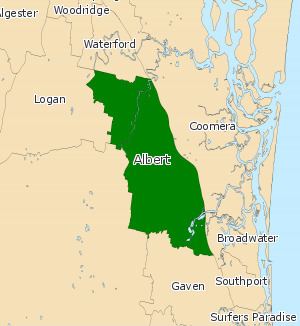Electors 36,716 (2015) Namesake Albert River | Area 235 km² Elector 36,716 (2015) | |
 | ||
Dates current 1888–1950, 1960–present Party Liberal National Party of Queensland | ||
Albert is a Legislative Assembly electorate in the state of Queensland. Albert is named for the Albert River, which runs through the electorate and separates Logan City from City of Gold Coast. It was first created in a redistribution in 1887 ahead of the 1888 colonial election and continued to exist (with various boundary alterations) until 1949, when the Darlington and Southport electorates were created. In 1959, the electorate was established again and exists to this day. The 1971 and 1977 redistributions greatly reduced the area of the electorate and minor changes were made in 1991, including the loss of Carbrook in the north and coastal areas below Paradise Point in the south.
Its consistently changing boundaries together with its existence in a high-growth area do not provide consistent political leanings over time, although it has shown more inclination towards the Labor Party over time than any other Gold Coast seat.
The present Member for Albert, Mark Boothman, was first elected in the 2012 election.
History
Historically, the Gold Coast and Logan regions were sparsely populated agricultural areas, and the Albert electorate covered the entire south-eastern corner of the state. Its representation broadly reflected the conservative leanings and rural interests of its population, and John Appel, who served in both the Second Kidston Ministry and Denham Ministry, participated in the formation of both the Queensland Farmers' Union from the rural caucus of the Ministerialist party in 1915 and the subsequent Country Party in 1919.
The seat's boundaries evolved thus:
It was split up in the 1949 redistribution ahead of the 1950 state election into Darlington, which included Redland, Logan, Beaudesert, Coomera, Jimboomba and Tamborine; and Southport which was limited to the Gold Coast and its hinterland. Both seats remained safe for the Country Party; Plunkett opted to contest the seat of Darlington.
At the 1960 state election, the fast-growing Southport seat was split into Albert in the north and South Coast in the south. Further urban growth pushed the seat progressively northwards.
Its present boundaries, as at the 2009 election, take in mostly urban, semi-urban and industrial areas west of the Pacific Motorway extending from Mount Warren Park and Windaroo in southern Logan to Coomera and Oxenford in the outer northern Gold Coast.
